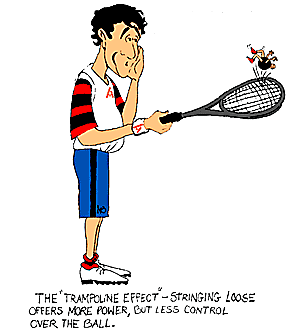|
|

Get Tight / Get Loose
By Steve Crandall
Vice President, Sales & Marketing
Ashaway Racket Strings
 Many squash players harbor misconceptions about racquet string tension. String tight or string loose for power or control? A lot of players get it wrong. Because string tension has a big influence on your game, it's important to understand it and get it right.
Many squash players harbor misconceptions about racquet string tension. String tight or string loose for power or control? A lot of players get it wrong. Because string tension has a big influence on your game, it's important to understand it and get it right.
Cut to the chase: tighter strings enhance control, while looser strings enhance power. How you use this information might vary from one player to the next, and there are exceptions and qualifications, which we'll get to in a moment. But the basic fact you need to know is worth repeating: string tight for control; loose for power.
In our last column, we explained how thin strings are power strings, because they stretch more when you hit the ball. More "trampoline effect" means more power. Thick strings are control strings, because the stringbed remains flatter. It's easier to control the direction of a bouncing ball when it's bouncing off a flat, stable surface.
The same goes for tension. Strings that are strung tight are already stretched almost as far as they'll go. When the ball makes impact, they can't stretch a lot more, which means not much trampoline effect, but a nice, flat stringbed for good control. Strings that are strung loose stretch a good deal upon impact with the ball, so lots of trampoline, but less control.
How tight is tight? 40 lb. is the maximum recommended by most squash racquet manufacturers. Much tighter than that, and you risk excessive string breakage, and even racquet breakage. Below 20 lb., control becomes extremely difficult because the strings shift around too much, and power begins to drop off as well. But within that 20-40 lb. range, you've got lots of room to tune your racquet.
You can use string tension to emphasize your strengths, minimize your weaknesses, or strike a happy medium. Power players-people who are physically strong-generally don't feel they need more power, so they usually string up tight to enhance control. Players who are less powerful tend to go either way. Many of them also string tight for maximum control, while others string loose to put a bit more pace on the ball. It's a personal decision.
The string and the racquet have to work together, and a certain amount of trial and error is usually required to find the exact tension that works best for you and your particular racquet. Larger racquets-especially those with very long heads-need slightly higher tension for comparable playability. You may also have to adjust tension based on the stiffness of the racquet itself. Some frames are very rigid (i.e., more control), while others are a bit "whippy" (i.e., more power). Don't be afraid to go up or down a couple pounds when you restring, looking for the ideal response.
Different stringing machines may produce very different results: for example, 30 lb. on one machine may be equivalent to 25 lb. on another. In order to get consistent results, find a stringer you like to work with and stay with him or her.
Strings lose tension naturally. Strings made from fibers like Zyex(r) and natural gut hold tension better than nylon strings, and they also tend to be more resilient. Most lose roughly 10 percent of their tension by the day after they're strung. The more you play, the greater the loss of tension.
When strings get looser because of tension loss, they become less powerful, not more, and they begin to lose their control properties. When your racquet no longer has that "zing," it's time for a new string job. Don't put it off.
This article previously appeared in Squash Magazine.
ZYEX® is a registered trademark of Victrex Ltd.
|